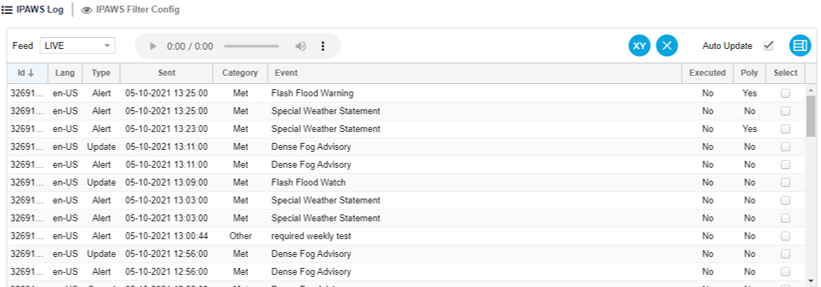IPAWS
The IPAWS section contains valuable information on notifications and alerts that utilize the Integrated Public Alert & Warning System (IPAWS). IPAWS, a system operated by the United States’ Federal Emergency Management Agency, expands the reach and situational awareness of GEM in the USA and Puerto Rico.
NOTE: IPAWS is only available in the USA and Puerto Rico.
IPAWS Log Page
The IPAWS Log page consists of a large table with all IPAWS notifications that exist in GEM. IPAWS notifications are logged in GEM in real time and are organized into several columns, which can be seen below.
IPAW Log Page Table
Default Columns: IPAWS Log Page Table
ID: Identification Number for the IPAWS notification.
Lang: Language in which the notification was issued.
Type: Type of IPAWS notification (alert, update, etc.).
Sent: Date and time at which the alert was issued. The date will be displayed according to user settings.
Category: Emergency that caused the notification (fire, rescue, safety etc.).
Alert: Alert that triggered the notification.
Executed: Indicates if the notification’s instructions have been carried out.
NOTE: Other columns are available and can be toggled using columns’ drop-down menus.
After finding the desired IPAWS notification, select the notification to see more details.
Selecting a notification will direct the map to the site of the notification. Selecting will also show the notification’s details in the IPAWS Log Details window, found at the bottom of the IPAWS Log page.
IPAWS Log Details Window
Fields: IPAWS Log Details Window
Block Channel: The IPAWS channel(s) disabled for the selected notification.
Wea Handling: Data specific to wireless notifications.
Id: Identification Number for the IPAWS notification in the system.
Identifier: The Identification Number for the IPAWS notification in the IPAWS system.
Sender: User that issued this IPAWS notification.
Sent: Date and time at which the alert was issued. The date will be displayed according to user settings.
Scope: Groups affected by the notification (public or private).
Category: Emergency that caused the notification (fire, rescue, safety etc.).
Alert: Alert that triggered the notification.
Response Type: Expected response from emergency services.
Urgency: Speed at which emergency services should respond and whether the occurrence was expected.
Severity: Degree of danger tied to the emergency that triggered the notification (ranging from minor to extreme).
Certainty: Level of certainty that the emergency is actually taking place.
Geocodes: Code representing the location of the emergency.
Area Description: Description of the location of the emergency.
Polygon: Code representing the location of the emergency. An alternative to geocodes.
Sound File: File used to broadcast sound (file use will depend on the notification).
Headline: Brief explanation of the emergency.
Description: Detailed explanation of the emergency.
Instruction: Instructions on how to deal with the emergency.
WEA Text: Short text for English wireless notification.
WEA Long: Long test for English wireless notification.
WEA Text Es: Short text for Spanish wireless notification.
WEA Long Es: Long text for Spanish wireless notification.
IPAWS Filter Config Page
This page contains a table with filters that are used to controls what IPAWS notifications are delivered to what phones and speakers.
Users can create and configure their own filters as needed on this page. Users can also modify existing filters.
To create a new filter, simply select the IPAWS Details window at the bottom of the IPAWS Filter Config page and start filling out the fields.
To modify an existing filter, first click the desired filter from the table. This will fill in the IPAWS Details window with the information associated with the selected filter. Then modify the fields where appropriate.
IPAWS Details Window
Fields: IPAWS Details Window
Templates: Alert template used with the filter.
Name: Name for the filter.
Activation Setup: The fields in this part of the window set the requirements that must be met for notifications to be activated and sent. It contains the following fields:
Category: The category of alert required to trigger a notification.
Sender: The person or people that can trigger a notification.
Scope: The specific groups that must be affected to trigger a notification.
Response Type: The response from emergency services required to trigger a notification.
Urgency: The level of urgency required to trigger a notification.
Severity: The level of severity required to trigger a notification.
Certainty: The level of certainty required to trigger a notification.
Once all fields are filled out, you can create a new filter from scratch or alter an existing filter and save it as a different one by pressing Save New.
To preserve changes made to an existing IPAWS Filter, press Save.’
Press Delete to delete the selected filter or press Clear to clear all fields.
The current functionality includes the reception of IPAWS messages from FEMA, which includes low level warnings on general weather patterns; IPAWS messages referring to our areas, can be automatic or manually sent to the output channels defined in a template.


